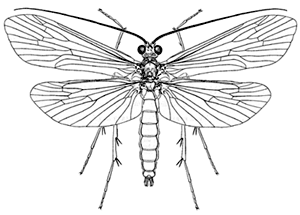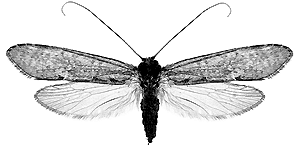|
Trichoptera:
caddisflies
Characteristics
Caddisflies
are related to Lepidoptera and resemble small hairy moths, but their
wings are covered in dense hairs rather than scales and they lack
the typical curled proboscis
of most moths and butterflies. They are mostly dull-coloured and
range in size from 2-40 millimetres in body length. Caddisflies
are recognisable by the following features:

Stenopsychodes species
|
|
- 2 pairs of
membranous
wings that are of differing size
- Wings covered
in fine hairs. Wings form a roof over the abdomen when at rest
Life Cycle
Caddisflies
mate during flight and one female can lay up to several hundred
eggs. Eggs are enclosed in a gelatinous mass either on or near the
water. The larvae
are aquatic and have a sclerotised
head and thorax
and well developed legs. They have a soft body, which they sheath
in a casing made from silk that they cover in various materials
such as sand or plant debris to provide protection and camouflage.
Caddisfly larvae
usually develop through 6-7 instars
and as they grow more material is added to the front of the protective
casing. Pupation
takes place underwater within the larval case or in a pupal case
made from silk. Most of the life cycle of caddisflies is spent in
the larval stage and the adults are generally short lived.
|

Leptoceridae larval species
|
Feeding
Adult
caddisflies do not feed but the larvae
have a wide variety of feeding methods and diets. The larvae
may be either herbivorous
or predatory.
Many feed on various plant materials both living and dead, some
feed on algae and others pierce plants sucking out the phloem
or xylem.
Others filter organic particles from the surrounding water or scrape
it off submerged rocks and plants. The predatory
species feed mainly on insects with some spinning silken nets to
capture prey.

Ethochorema brunneum
|
Habitat
Adults
are predominately found near water bodies, as their young are aquatic.
Although there is one species in Australia that has terrestrial
larvae.
The adults are nocturnal
and can sometimes be found resting on tree trunks by streams and
lakes during the day. The larvae
live in almost all types of freshwater habitats and a few species
even inhabit saline waters and marine environments. Water conditions
are important to different caddisfly species. Parameters such as
oxygen, temperature, chemicals and particulate matter in the water
often directly correspond to the presence or absence of certain
species in an area. As such caddisfly larvae
are sometimes used as environmental indicators of water quality
in these areas.
|